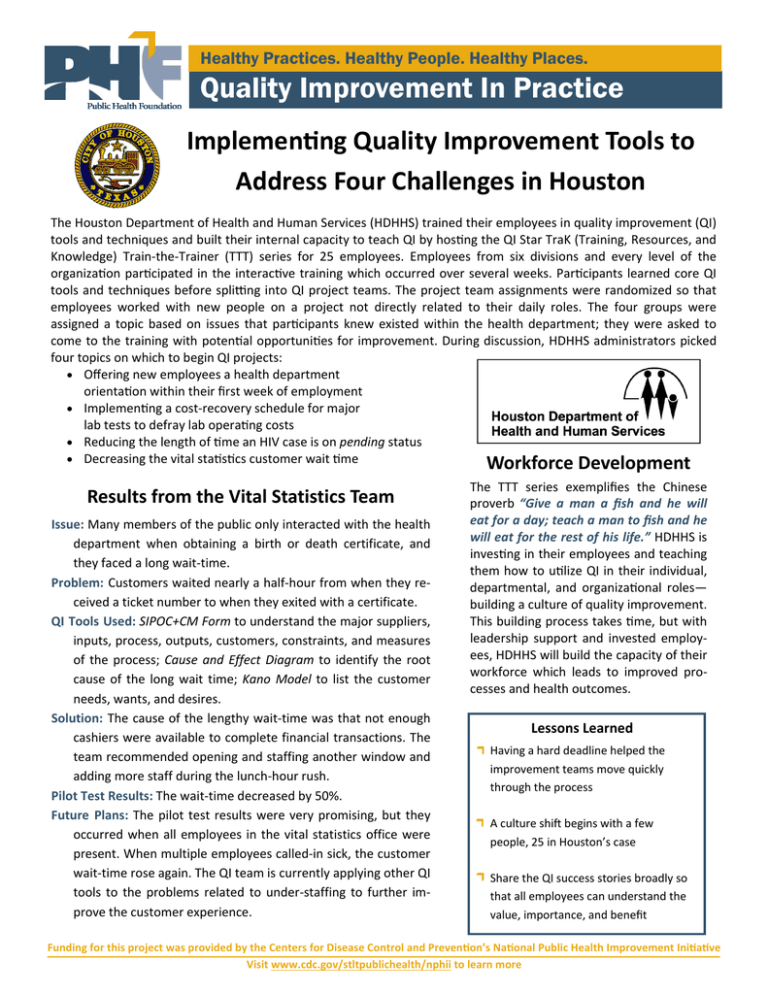Quality Improvement In Practice ImplemenƟng Quality Improvement Tools to
advertisement

Healthy Practices. Healthy People. Healthy Places. Quality Improvement In Practice ImplemenƟng Quality Improvement Tools to Address Four Challenges in Houston The Houston Department of Health and Human Services (HDHHS) trained their employees in quality improvement (QI) tools and techniques and built their internal capacity to teach QI by hos ng the QI Star TraK (Training, Resources, and Knowledge) Train‐the‐Trainer (TTT) series for 25 employees. Employees from six divisions and every level of the organiza on par cipated in the interac ve training which occurred over several weeks. Par cipants learned core QI tools and techniques before spli ng into QI project teams. The project team assignments were randomized so that employees worked with new people on a project not directly related to their daily roles. The four groups were assigned a topic based on issues that par cipants knew existed within the health department; they were asked to come to the training with poten al opportuni es for improvement. During discussion, HDHHS administrators picked four topics on which to begin QI projects: Offering new employees a health department orienta on within their first week of employment Implemen ng a cost‐recovery schedule for major lab tests to defray lab opera ng costs Reducing the length of me an HIV case is on pending status Decreasing the vital sta s cs customer wait me Workforce Development Results from the Vital Statistics Team Issue: Many members of the public only interacted with the health department when obtaining a birth or death certificate, and they faced a long wait‐time. Problem: Customers waited nearly a half‐hour from when they re‐ ceived a ticket number to when they exited with a certificate. QI Tools Used: SIPOC+CM Form to understand the major suppliers, inputs, process, outputs, customers, constraints, and measures of the process; Cause and Effect Diagram to identify the root cause of the long wait time; Kano Model to list the customer needs, wants, and desires. Solution: The cause of the lengthy wait‐time was that not enough cashiers were available to complete financial transactions. The team recommended opening and staffing another window and adding more staff during the lunch‐hour rush. Pilot Test Results: The wait‐time decreased by 50%. Future Plans: The pilot test results were very promising, but they occurred when all employees in the vital statistics office were present. When multiple employees called‐in sick, the customer wait‐time rose again. The QI team is currently applying other QI tools to the problems related to under‐staffing to further im‐ prove the customer experience. The TTT series exemplifies the Chinese proverb “Give a man a fish and he will eat for a day; teach a man to fish and he will eat for the rest of his life.” HDHHS is inves ng in their employees and teaching them how to u lize QI in their individual, departmental, and organiza onal roles— building a culture of quality improvement. This building process takes me, but with leadership support and invested employ‐ ees, HDHHS will build the capacity of their workforce which leads to improved pro‐ cesses and health outcomes. Lessons Learned Having a hard deadline helped the improvement teams move quickly through the process A culture shi begins with a few people, 25 in Houston’s case Share the QI success stories broadly so that all employees can understand the value, importance, and benefit Funding for this project was provided by the Centers for Disease Control and PrevenƟon’s NaƟonal Public Health Improvement IniƟaƟve Visit www.cdc.gov/stltpublichealth/nphii to learn more —————————————————————————————————————————————————————————————————————————

